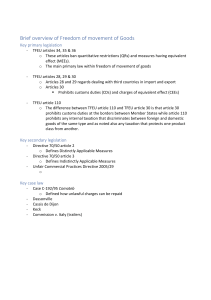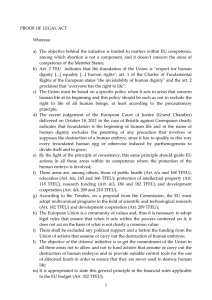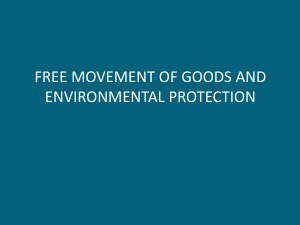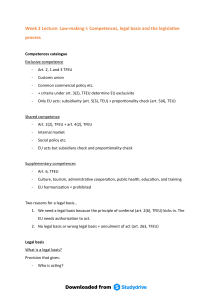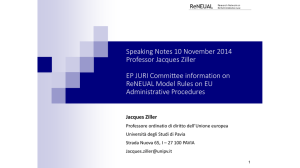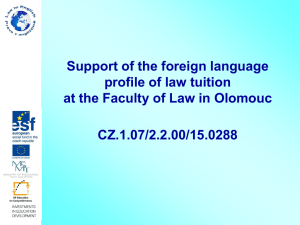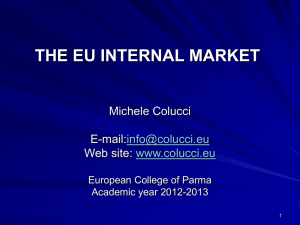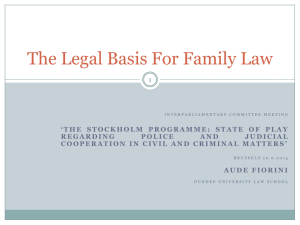Leading cases on Art. 34 TFEU.
advertisement
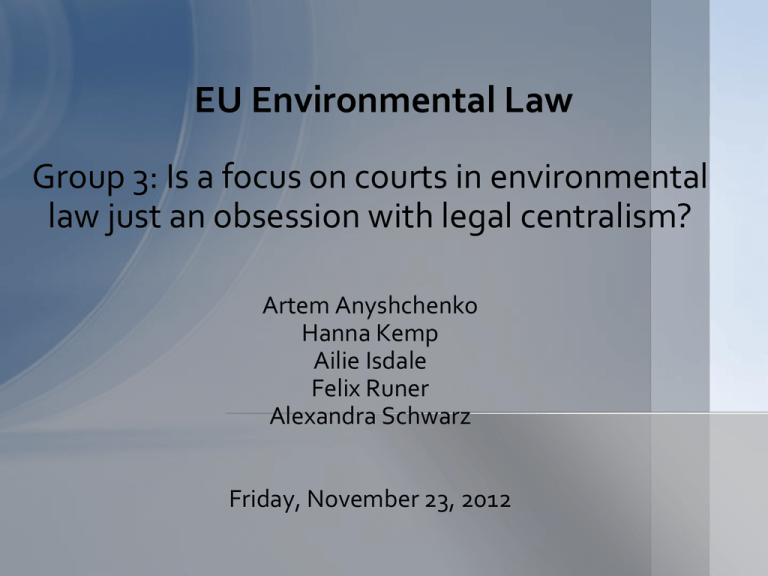
EU Environmental Law Group 3: Is a focus on courts in environmental law just an obsession with legal centralism? Artem Anyshchenko Hanna Kemp Ailie Isdale Felix Runer Alexandra Schwarz Friday, November 23, 2012 Presentation Overview • • • • • • The Problem Question Layout of the Issue Relevant Law Application of the Law to the Issues Analysis of the Case Law Analysis of Gaps and Suggestions for Improvement The Problem Question • Environmental law is generally accepted as public law involving administrative decisions of public authorities. Therefore, the way to challenge the environmental decisions of public authorities is through (administrative) judicial procedure rather than through civil law dispute resolution. The role of courts can’t be overestimated since they execute: • Judicial review; • Gap filling; • Protection of fundamental rights. A Layout of the Issue “The focus on courts in environmental law can be explained by that ‘terms such as rules, principles, legal principles, objectives and guidelines are used incoherently to mean similar and different things’” “Hence the significance of considering environmental case law where these concepts have been raised as it is only here that one will begin to discern their true legal nature in practice by seeing how they are handled and treated by the judiciary in influencing the outcome of disputes” In Other Words… What is the courts’ true objective? What are they aiming to achieve? Article 19: The Court of Justice of the European Union shall include the Court of Justice, the General Court and specialised courts. It shall ensure that in the interpretation and application of the Treaties the law is observed. The Relevant Law • Article 11 TFEU (ex Article 6 EC) Environmental protection requirements • Articles 191-193 TFEU (ex Articles 174-176 EC) the EU’s powers • The extent of “legal centralism” in relation to the courts’ role Application of the Law to the Issues • Maintaining balance between environmental protection and the freedoms of internal market. • Is the objective of environmental protection sought by the measure acceptable under the applicable rules? • If that objective is acceptable, are the measures adopted proportionate, that is, are they the most effective to achieve that objective while the least harmful to other interests and values? Application of the Law to the Issues • At the EU level, there is a wide margin of discretion in adopting legislative measures in the field of environmental law that involve complex political and economic choices. • The Court can extensively expand its own jurisdiction and employ a “generous” approach to interpretation of EU law in order to enhance environmental protection. Leading cases on Art. 34 TFEU 8/74 Dassonville • • The court grants itself broad powers to supervise national measures Art. 34 – traditional view of free trade and equal treatment. C-120/78 - Cassis de Dijon • • • Principles of mutual recognition Discriminatory recognition Rule of reason 267/91 – 268/91 Keck and Mithouard • To have an effect on trade a selling arrangement a measure must: – Have a greater effect on foreign goods than domestic. – Effectively prevent the sale of certain imports. Increasing Acceptance? C-315/86 Commission v Denmark • Environmental protection can be considered a mandatory requirement. • Measure not within Art. 36 exceptions: rule of reason not applicable.. C-309/02 Radlberger Getränkegesellschaft • A more accepting weighing of environment v. trade. C-67/97 Bluhme • Protection of biodiversity under “protection of animals” in Art. 36 TFEU. • Introduced international conventions as a context. C-2/90 Walloon Waste • Overtly discriminatory measure – prohibited in Art. 34 • Did not fall under mandatory requirements (Cassis) or Art.36 • ECJ: Non-discriminatory considering the nature of the goods. A strange wording with unclear meaning for future cases. C-379/98 PreussenElektra • • Environmental derogation available in the Treaty. A stretch of the “protection of human life”? Like Bluhme, the court was very context aware, seeing as the current environmental situation may be a sensitive issue. C-203/96 Afvalstoffen Dusseldorp • Export restriction – unfair advantage to local company coupled with lack of evidence of an export resulting in a health risk. C-142/05 Mickelsson and Roos/ C-110/05 Commission v. Italy • • Limitations on use may constitute a “considerable influence” on consumers, and hereby fall under Art. 34 TFEU. Customers have a “limited interest” in buying the product – quasi ban due to limited possibilities of use in the Mickelsson case. The Proportionality Test: Case-Law C-240/83 ADBHU • Directive regulating the disposal of waste oils found to be respecting the principles of proportionality and non-discrimination and was not contrary to the free-trade principles. C 389/96 Aher-Waggon • The German legislation on noise control found proportionate. C-473/98 Toolex • a measure imposing a total ban on the industrial use of a particular carcinogenic substance found proportionate to the aim of protecting public health and environment. Continued C-284/95 Safety Hi-Tech • A regulation prohibiting the use of HCFCs found proportionate to its aim of protecting the ozone layer. C/27/00 Omega Air • Regulation aiming at reduction of noise caused by jet aeroplanes proportionate. Lacunas in the Applicable Legal System • Lack of Treaty explicit provision regarding the protection of the environment (Article 36 TFEU: “the protection of health and life of humans, animals or plants”). • Lack of cooperation (in this respect, difficulties in balancing of conflicting interests). • Lack of harmonization (in this respect, more stringent measures set up by Member States). Conclusions and Suggestions for Improvement
